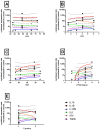Pro-Inflammatory Cytokine Gene Expression in Penile Cancer: Preliminary Studies
- PMID: 37763742
- PMCID: PMC10535686
- DOI: 10.3390/medicina59091623
Pro-Inflammatory Cytokine Gene Expression in Penile Cancer: Preliminary Studies
Abstract
Background and Objectives: Penile cancer is a rare neoplasm in developed countries with an incidence of 0.8/100,000 per male inhabitant. Despite the development of personalized medicine and multimodal treatment, the outcome of penile cancer treatment is insufficient. Our study aimed to assess the levels of pro-inflammatory cytokines' mRNA such as interleukin 1-A (encoded by IL1A gene, alias IL-1A), interleukin 1-B (IL1B, IL-1B), interleukin 1 receptor antagonist (IL1RN, IL-1RN), interleukin 6 (IL6, IL-6), transforming growth factor β1 (TGFB1, TGFβ-1), and Interferon-gamma (INFG, INF-γ) in penile cancer tissue and associate them with tumor progression and patient survival. Material and Methods: Skin biopsies from patients suffering from penile cancer (n = 6) and unchanged foreskin from 13 healthy adult males undergoing circumcision due to a short frenulum were obtained. Pro-inflammatory cytokine mRNA levels were quantified through qPCR. Results: We observed higher expression of pro-inflammatory cytokine genes (IL-1A, IL-1B, IL-6, INF-γ, TGF-β) in penile cancer tissue. The average follow-up period was 48 months (range: 38-54 months), during which only one penile tumor progression was observed However, this was without association with the nature of tumor (patient refused radical treatment). Conclusions: This is the first study to show increased expression of cytokines such as IL-1A, IL-1B, IL-6, INF-γ, and TGF-β in penile cancer with positive correlation between TNM staging and INF-γ levels in tumor samples (rs = 0.672, p = 0.045), which may be associated with the immunosuppressive role of the tumor environment.
Keywords: IFN-γ; IL-1; IL-1RN; IL-6; TGF-β1; penile cancer.
Conflict of interest statement
The authors declare no conflict of interest.
Figures


Similar articles
-
The role of occlusion and micro-incontinence in the pathogenesis of penile lichen sclerosus: an observational study of pro-inflammatory cytokines' gene expression.Int Urol Nephrol. 2022 Apr;54(4):763-772. doi: 10.1007/s11255-022-03130-7. Epub 2022 Feb 1. Int Urol Nephrol. 2022. PMID: 35103930 Free PMC article.
-
Cytokine mRNA expression in whole blood samples from dogs with natural canine distemper virus infection.Vet Immunol Immunopathol. 1998 Sep 16;65(1):11-27. doi: 10.1016/s0165-2427(98)00170-6. Vet Immunol Immunopathol. 1998. PMID: 9802573
-
Cytokine mRNA expression in intestinal tissue of interleukin-2 deficient mice with bowel inflammation.Gut. 1997 Dec;41(6):793-800. doi: 10.1136/gut.41.6.793. Gut. 1997. PMID: 9462212 Free PMC article.
-
Interferon-gamma, interleukin-4 and transforming growth factor-beta mRNA expression in multiple sclerosis and myasthenia gravis.Acta Neurol Scand Suppl. 1994;158:1-58. Acta Neurol Scand Suppl. 1994. PMID: 7732782
-
Molecular and genetic pathways in penile cancer.Lancet Oncol. 2007 May;8(5):420-9. doi: 10.1016/S1470-2045(07)70137-7. Lancet Oncol. 2007. PMID: 17466899 Review.
Cited by
-
Neutrophil-to-lymphocyte ratio predicts a poor prognosis for penile cancer with an immunosuppressive tumor microenvironment.Front Immunol. 2025 Apr 16;16:1568825. doi: 10.3389/fimmu.2025.1568825. eCollection 2025. Front Immunol. 2025. PMID: 40308599 Free PMC article.
-
Identification of new tissue markers for the monitoring and standardization of penile cancer according to the degree of differentiation.Histol Histopathol. 2025 Jul;40(7):1013-1039. doi: 10.14670/HH-18-846. Epub 2024 Nov 7. Histol Histopathol. 2025. PMID: 39600260
-
Penile Cancer Profile in a Central European Context: Clinical Characteristics, Prognosis, and Outcomes-Insights from a Polish Tertiary Medical Center.Cancers (Basel). 2025 Jun 25;17(13):2140. doi: 10.3390/cancers17132140. Cancers (Basel). 2025. PMID: 40647438 Free PMC article.
-
Inflammation in Penile Squamous Cell Carcinoma: A Comprehensive Review.Int J Mol Sci. 2025 Mar 19;26(6):2785. doi: 10.3390/ijms26062785. Int J Mol Sci. 2025. PMID: 40141426 Free PMC article. Review.
References
MeSH terms
Substances
Grants and funding
LinkOut - more resources
Full Text Sources
Miscellaneous

